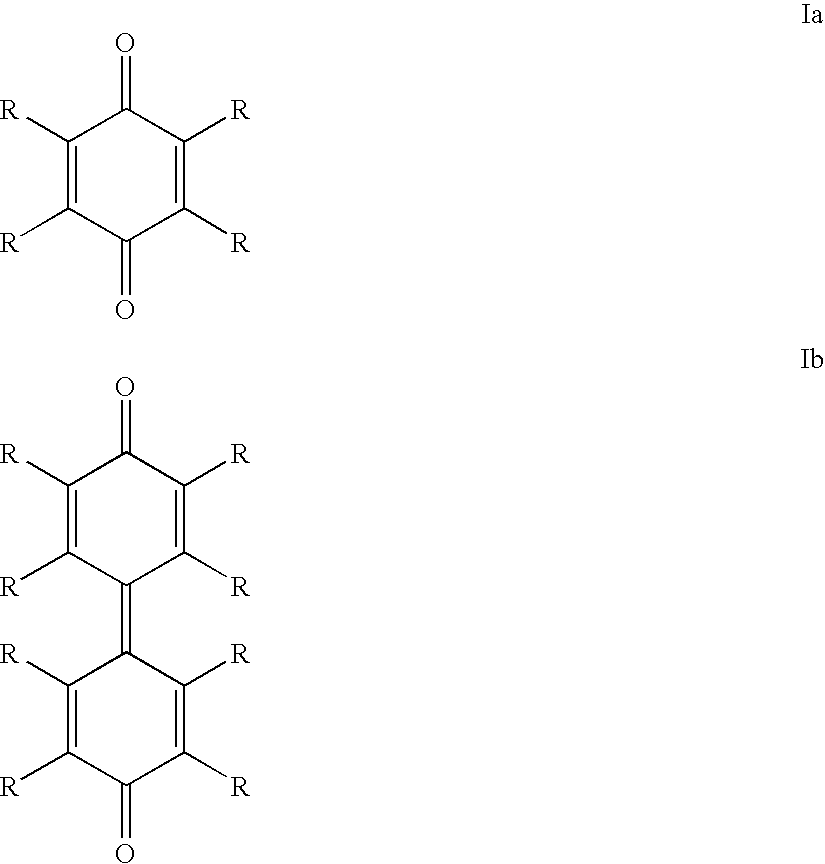Method for the emulsion polymerization of olefins
- Summary
- Abstract
- Description
- Claims
- Application Information
AI Technical Summary
Benefits of technology
Problems solved by technology
Method used
Image
Examples
working examples
[0152]General notes: The syntheses, unless otherwise described, were carried out in accordance with the Schlenk technique in the absence of air and moisture.
[0153]The molar masses of the polymers obtained were determined by means of GPC.
[0154]In accordance with DIN 55672, the conditions chosen were as follows: solvent: 1,2,4-trichlorobenzene; flow rate: 1 ml / min; temperature: 140° C. Measurement was carried out on a Waters 150C instrument which had been calibrated using polyethylene standards.
[0155]The solids content was determined by precipitating the polyethylene from methanol.
example 1
Starting from 2,3,5,6-tetrachloro-p-benzoquinone
[0156]64 mg (258 μmol) of 2,3,5,6-tetrachloro-p-benzoquinone and 68 mg (258 μmol) of triphenylphosphine were dissolved in 1 ml of methanol (dried and degassed), 4 ml of toluene (dried and degassed) and 0.3 ml of hexadecane (degassed). The solution obtained was stirred for 20 minutes, during which it turned orange in color. The solution was then introduced into another Schlenk flask, which contained 79 mg (287 μmol; 1.11 eq) of nickel-(cyclooctadiene)2 [Ni(cod)2].
[0157]In the interim, a solution of 1 g of sodium dodecyl sulfate [SDS] in 95 ml of degassed and deionized water was prepared. 75 ml of this aqueous solution were introduced directly into the reactor, the other 20 ml were added to the catalyst mixture and subjected to ultrasound treatment (120 W, 2 minutes). The miniemulsion obtained in this way was then introduced into the reactor using a hollow Teflon needle.
[0158]The reactor was subsequently filled with ethylene, setting a c...
example 2
Starting from 2,3,5,6-tetrachloro-p-benzoquinone
[0160]64 mg (258 μmol) of 2,3,5,6-tetrachloro-p-benzoquinone and 68 mg (258 μmol) of triphenylphosphine were dissolved in 1 ml of methanol (dried and degassed), 4 ml of toluene (dried and degassed) and 0.3 ml of hexadecane (degassed). The solution obtained was stirred for 20 minutes, during which it turned orange in color. The solution was then introduced into another Schlenk flask, which contained 79 mg (287 μmol; 1.11 eq) of nickel-(cyclooctadiene)2 [Ni(cod)2].
[0161]In the interim, a solution of 1 g of SDS in 95 ml of degassed and deionized water was prepared. 75 ml of this aqueous solution were introduced directly into the reactor, the other 20 ml were added to the catalyst mixture and subjected to ultrasound treatment (120 W, 2 minutes). The miniemulsion obtained in this way was then introduced into the reactor using a hollow Teflon needle.
[0162]The reactor was subsequently filled with but-1-ene, setting a constant but-1-ene pressu...
PUM
| Property | Measurement | Unit |
|---|---|---|
| Percent by volume | aaaaa | aaaaa |
| Ratio | aaaaa | aaaaa |
| Molar ratio | aaaaa | aaaaa |
Abstract
Description
Claims
Application Information
 Login to View More
Login to View More - R&D
- Intellectual Property
- Life Sciences
- Materials
- Tech Scout
- Unparalleled Data Quality
- Higher Quality Content
- 60% Fewer Hallucinations
Browse by: Latest US Patents, China's latest patents, Technical Efficacy Thesaurus, Application Domain, Technology Topic, Popular Technical Reports.
© 2025 PatSnap. All rights reserved.Legal|Privacy policy|Modern Slavery Act Transparency Statement|Sitemap|About US| Contact US: help@patsnap.com



